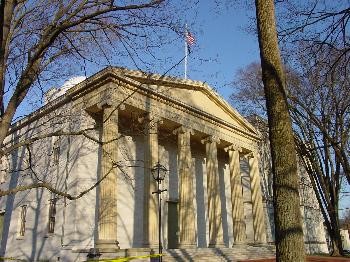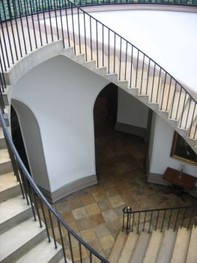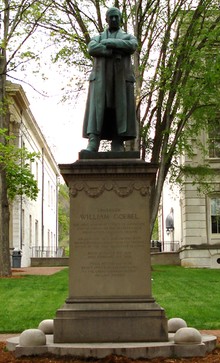Old State Capitol of Kentucky
Introduction
Text-to-speech Audio
Frankfort was selected as the location for the capital of the new state of Kentucky in 1793. Kentucky's Old State House is the third permanent capitol erected on Frankfort's old public square. On January 12, 1827, the legislature voted to build a new state house as two previous structures on this site had burned. The first structure was destroyed in 1813 and the second in 1824. Constructed between 1827 and 1830, the Old State House was the first major work of Kentucky’s first native trained architect, Gideon Shryock. Through its history, the structure witnessed debates on Kentucky’s loyalty’s during the Civil War, the assassination of a Governor, and the ratification of Kentucky’s current Constitution.
Images
Exterior of the Old Capital

Staircase at the Old Capital

Statue of William Goebel. Kentucky Governor assassinated on the grounds of the Old Capital in 1900.

Backstory and Context
Text-to-speech Audio
The architectural style of the building is
significant as it represents the introduction of the Greek Revival style into
Kentucky and the pioneering west. Shryock drew inspiration from the classical
Temple of Minerva Polias at Priene, Ionoa. It is faced in polished Kentucky
River marble, limestone quarried near Frankfort. Six massive Ionic columnns,
each four feet in diameter and 33 feet high, adorn the building's facade.
Among the Old Capitals unique architectural elements is the self-supporting, marble, double staircase which rises from a large central rotunda. While the building features many original pieces, the legislative chambers have been furnished with reproduction desks and chairs. Shryock’s building functioned as Kentucky’s capital until 1909.1
Controversial Kentucky politician William Goebel, won a bitter election for Governor in 1899. Goebel had once killed a former Confederate General in broad daylight in Covington. In a close four-way election, Goebel’s supporters accused the apparent winner of benefitting from a fraudulent election. The Republican candidate, William S. Taylor, was declared the winner. Once the legislature was seated in 1900, Goebel supporters launched an investigation of the election. Armed Taylor supporters arrived in Frankfort determined to keep Taylor in office. On January 30, 1900 William Goebel was shot while walking to the Capital Building. Acting governor Taylor removed Republican lawmakers to London, while Democrat lawmakers remained in Frankfort. With the Republicans absent, the remaining Democrats declared Goebel Governor. He died on February 3, 1900. A statue commemorating Goebel stands on the grounds of the Old Capital.2
Among the Old Capitals unique architectural elements is the self-supporting, marble, double staircase which rises from a large central rotunda. While the building features many original pieces, the legislative chambers have been furnished with reproduction desks and chairs. Shryock’s building functioned as Kentucky’s capital until 1909.1
Controversial Kentucky politician William Goebel, won a bitter election for Governor in 1899. Goebel had once killed a former Confederate General in broad daylight in Covington. In a close four-way election, Goebel’s supporters accused the apparent winner of benefitting from a fraudulent election. The Republican candidate, William S. Taylor, was declared the winner. Once the legislature was seated in 1900, Goebel supporters launched an investigation of the election. Armed Taylor supporters arrived in Frankfort determined to keep Taylor in office. On January 30, 1900 William Goebel was shot while walking to the Capital Building. Acting governor Taylor removed Republican lawmakers to London, while Democrat lawmakers remained in Frankfort. With the Republicans absent, the remaining Democrats declared Goebel Governor. He died on February 3, 1900. A statue commemorating Goebel stands on the grounds of the Old Capital.2
Sources
1) “Old State Capital”, Kentucky Division of Historic Properties, accessed June 20, 2015, http://historicproperties.ky.gov/hp/oldstate+capitol/
2) “History of Kentucky Governors”, Kentucky Governors and Elections, 2001, accessed June 20, 1900, http://www.historykygovenors.com/williamgoebel.htm
